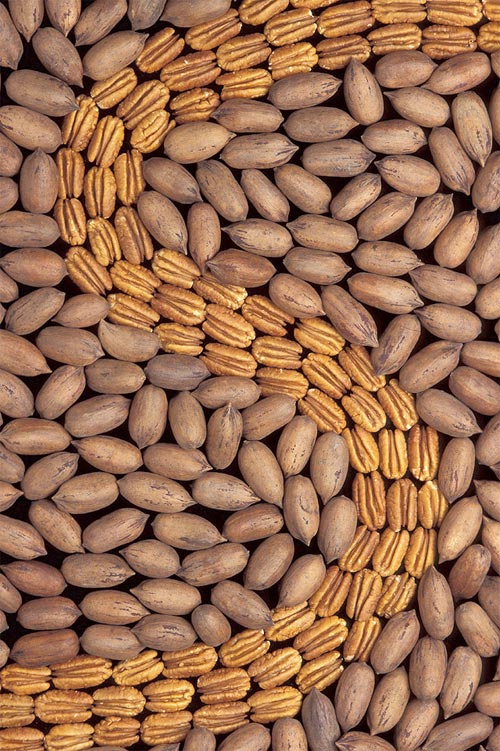May 27, 2010

Controlling insects is essential for profitable pecan production, Mike Hall, an LSU AgCenter entomologist, told pecan growers at the LSU AgCenter’s May 20 Pecan Research and Extension Station field day.
Knowing how to look for the major pests during the growing season is important in determining if an insecticide application is needed and when it should be applied.
Saying he is beginning to get calls from various parts of Louisiana about the pecan weevil, Hall demonstrated weevil traps — including cones, pyramids and circles — that can be effective in monitoring. Traps should be put out at the end of July and monitored through September.
Pecan weevil damage often is first observed by cracking open a nut and finding a white, legless larva inside or by finding a hollow pecan with a small hole in the shell where the larva had emerged after consuming the entire kernel.
Hall also discussed his phylloxera emergence studies in Monroe and Shreveport. Phylloxera is a tiny insect that can produce galls on plant tissue.
“The focus is to determine when they come out, the period of peak activity and the period of time they emerge,” Hall said. “The data will help growers know when insects are active and better time insecticide applications.”
Hall is researching options for small producers and homeowners without spray equipment. These include a trunk injection, trunk spray and soil application of insecticide to possibly control phylloxera.
Hall sends e-mail updates on insect activity, and growers can contact him at [email protected] to get on his list.
Hall said the pH of water can affect insecticides. “Before you spray, check your water pH each time.”
“Some chemicals will start breaking down 30 minutes after being exposed to very alkaline water,” explained Roberto Barbosa, LSU AgCenter specialist in precision systems and aerial application.
Barbosa said farmers’ objectives should be to perform initial pesticide application properly to get their money’s worth. He suggested cleaning nozzle tips weekly because they can get plugged up with impurities in water.
“Clogged nozzles will not deliver the same amount of product and will affect coverage.”
Watch the weather when you spray, Barbosa added. “Winds should be less than 20 miles per hour during spraying.” Barbosa said to avoid spraying immediately before it rains.
Randy Sanderlin, LSU AgCenter plant pathologist, said he is excited about a new class of fungicide — the first in 14 years — for pecan scab disease, the most costly disease to control on pecan trees.
“Generally, a fungicide attacks the pathogen,” Sanderlin said. “This one will help the host plant induce resistance, kind of like a vaccine.”
Sanderlin also addressed bacterial leaf scorch disease, which can cause severe defoliation and loss of pecans. The disease can be transmitted through insects and grafting.
Sanderlin’s research involves determining how the pathogen moves into orchards, the pattern and rate of pathogen spread within orchards, the identity of insect vectors that feed on pecans, the frequency of occurrence of the disease in pecan nurseries and the relationship of the pecan pathogen to subspecies of the bacterium from other hosts.
Sanderlin is glad to work with growers who want to put out sticky traps for monitoring insect vectors of bacterial leaf scorch.
In addressing thinning as a useful commercial management tool, Sanderlin reported on a pecan station study that indicates thinning improves return bloom.
“Trees that were cropped thin last year have more than double the return of the crop this year than ones not thinned. But a lot of growers are reluctant to do it. The down side is you’re going to break some bark off of the trees. Certainly, it damages the trees, but so far, we haven’t seen any trees die from it.”
Some varieties respond better than others, Sanderlin said.
Charlie Graham, LSU AgCenter research horticulturalist, who is investigating a growth regulator to keep nuts from dropping prematurely, reported that the LSU AgCenter Dean Lee Research Station near Alexandria is the site of a U.S. Department of Agriculture pecan breeding and genetics program. The National Pecan Advanced Clone Testing System test, to last 15 years, is evaluating pecan varieties under Louisiana growing conditions.
Graham said the most fundamental step in pecan production is the selection of varieties to be planted in the orchard. Characteristics that should be considered in a breeding program are pollination type, harvest date, nut size and quality, and disease resistance.
At the close of the field day, pecan grower Ben Littlepage, of Colfax, La., received a plaque in recognition of 37 years of service and support to the LSU AgCenter Pecan Station.
You May Also Like




